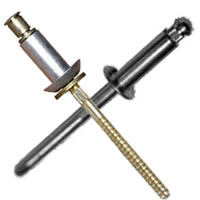
Fasteners are an essential part of all airplanes. Commercial jets, for instance, contain an average of 1.5 to 3 million fasteners. Fasteners are used to hold components together. Two of the most common types of fasteners used in the construction of airplanes are bolts and rivets. What are bolts and rivets exactly, and how do they differ?
What Are Bolts?
Bolts are fasteners consisting of a threaded shank and a head. The shank is the main cylindrical body of a bolt. All bolts have a shank, which is either partially or fully threaded depending on the bolt type.
At the top of a bolt is the head. To install a bolt, you’ll need to use a bit that accommodates the bolt’s head. If a bolt has a hexagonal head without a recess, you can use a hex socket bit to install it
What Are Rivets?
Rivets are fasteners consisting of an unthreaded shank. Like with bolts, they typically have a head at the top. They are used to hold components together. Rivets can hold multiple components together, including aerospace components.
There are several types of rivets. Solid rivets consist of a solid shank and a head. Blind rivets, conversely, are designed for fastening applications where you can’t access the back of a workpiece.
Differences Between Bolts and Rivets
While they are both used to join two or more components, bolts and rivets aren’t the same. Only bolts have threading. Bolts are designed for use inside threaded holes. You can install a bolt by driving it into a threaded hole. The bolt’s threading will catch with the hole’s threading.
Most rivets don’t have threading. They still have a shank, but there’s no threading on the shank. The shank on a typical rivet is smooth. You can install rivets by inserting the smooth shank into a hole.
Another difference between the bolts and rivets involves their installation. You can install bolts using a traditional driver with the appropriate bit. Rivets, on the other hand, may require a special tool. Blind rivets, for example, typically require a special tool to install.
Bolts are temporary fasteners, whereas rivets are permanent fasteners. You can easily remove bolts after installing them; you just need to use the same bit that you used to install the bolts but in reverse. Rivets are permanent fasteners, so you can’t easily remove them. Some rivets will even break off during installation.



